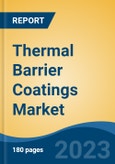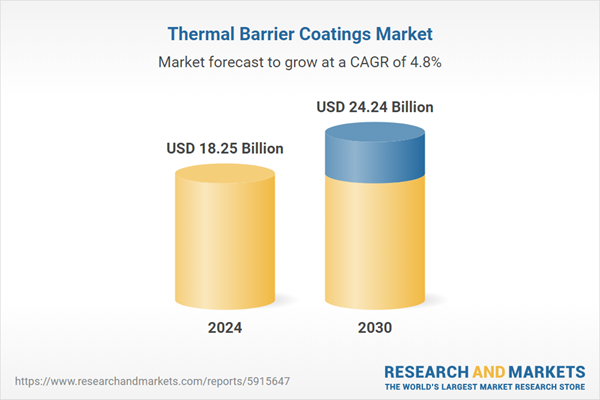Speak directly to the analyst to clarify any post sales queries you may have.
10% Free customizationThis report comes with 10% free customization, enabling you to add data that meets your specific business needs.
The market's geographical landscape is diverse, with North America, Europe, Asia-Pacific, and other regions each contributing significantly to its growth. Particularly, the Asia-Pacific region is experiencing robust growth, driven by rapid industrialization, increasing aerospace activities, and the expansion of the automotive sector in countries like China and India.
The energy sector, which includes power generation and renewable energy, represents another key market for thermal barrier coatings. These coatings are used in gas turbines, boilers, and various power plant components to enhance efficiency and reduce heat-related wear. The growing emphasis on clean and sustainable energy further drives the demand for thermal barrier coatings.
Key Market Drivers
Rising Demand from Aerospace and Defense Sectors
The aerospace and defense industry is a major growth driver for the global thermal barrier coatings market. As this sector relies heavily on high-performance coatings to improve efficiency, durability, and safety, the demand for advanced thermal management solutions is increasing. The global aviation industry is experiencing steady growth in commercial aircraft production due to rising passenger traffic, airline investments, and expansion into emerging markets. Additionally, companies like Hical Technologies and JJG Aero are positioning themselves as key players in India’s aerospace sector, capitalizing on growing opportunities.As aircraft manufacturers such as Boeing and Airbus increase production to meet rising demand, the need for thermal barrier coatings in jet engines and turbine components also grows. The development of next-generation aircraft, including supersonic and electric models, requires sophisticated thermal management systems, further boosting market demand. Additionally, the push for fuel efficiency in the face of rising fuel prices and stringent emission regulations is driving demand for coatings that can help optimize engine performance. TBCs are vital in improving thermal efficiency by allowing engines to operate at higher temperatures without damaging components, thereby extending their lifespan.
Governments are also increasing defense spending, leading to a surge in military aircraft and defense-related technologies. The demand for thermal barrier coatings is particularly high in jet engines, missile systems, and unmanned aerial vehicles (UAVs), as these technologies operate under extreme conditions and require robust thermal protection.
Key Market Challenges
Environmental Regulation Compliance
The thermal barrier coatings market faces a significant challenge in adapting to increasingly stringent environmental regulations. As industries are pressured to reduce their carbon footprint, thermal coating manufacturers must reformulate their products to meet eco-friendly standards. Traditional coating formulations, while effective in providing thermal protection, may contain components that pose environmental risks during production or disposal.Additionally, the disposal of coatings at the end of their lifecycle has become a growing concern. Environmental agencies are advocating for responsible disposal practices, which is pushing manufacturers to innovate solutions for recycling or disposing of coatings safely. The financial costs associated with transitioning to environmentally compliant formulations and upgrading manufacturing processes can strain the budgets of companies, particularly smaller players in the market.
Key Market Trends
Growing Demand in Aerospace and Automotive Sectors
The demand for thermal barrier coatings is experiencing significant growth in both the aerospace and automotive sectors. In aerospace, manufacturers are increasingly relying on these coatings to withstand extreme temperatures in aircraft engines, contributing to improved durability and engine efficiency. Meanwhile, the automotive industry is undergoing a transformation with the rise of electric vehicles (EVs). Thermal barrier coatings are crucial in managing heat generated by lithium-ion batteries in EVs, ensuring optimal performance and longevity.Key Market Players
- A&A Thermal Spray Coatings
- Chromalloy Gas Turbine LLC
- CTS, Inc.
- Hayden Corp.
- Honeywell International Inc.
- KECO Coatings
- Metallic Bonds, Ltd.
- Northwest Mettech Corp.
- OC Oerlikon Management AG
- Praxair S.T. Technology, Inc.
Report Scope
This report segments the global thermal barrier coatings market by product, end-user industry, and region, with detailed insights into trends and opportunities.By Product:
- Metal
- Ceramic
- Intermetallic
- Others
By End-User Industry:
- Automotive
- Aerospace
- Power Plants
- Oil and Gas
- Others
By Region:
- North America (United States, Canada, Mexico)
- Europe (France, United Kingdom, Italy, Germany, Spain)
- Asia-Pacific (China, India, Japan, Australia, South Korea)
- South America (Brazil, Argentina, Colombia)
- Middle East & Africa (South Africa, Saudi Arabia, UAE)
Competitive Landscape
Company Profiles
A detailed analysis of key companies in the thermal barrier coatings market is included in this report.Available Customizations:
TechSci Research offers customization options for the global thermal barrier coatings market report according to specific company needs, including additional company profiles and analysis.Company Information
- Detailed analysis and profiling of additional market players (up to five).
This product will be delivered within 1-3 business days.
Table of Contents
Companies Mentioned
- A&A Thermal Spray Coatings
- Chromalloy Gas Turbine LLC
- CTS, Inc.
- Hayden Corp.
- Honeywell International Inc.
- KECO Coatings
- Metallic Bonds, Ltd.
- Northwest Mettech Corp.
- OC Oerlikon Management AG
- Praxair S.T. Technology, Inc.
Table Information
| Report Attribute | Details |
|---|---|
| No. of Pages | 185 |
| Published | February 2025 |
| Forecast Period | 2024 - 2030 |
| Estimated Market Value ( USD | $ 18.25 Billion |
| Forecasted Market Value ( USD | $ 24.24 Billion |
| Compound Annual Growth Rate | 4.8% |
| Regions Covered | Global |
| No. of Companies Mentioned | 10 |









